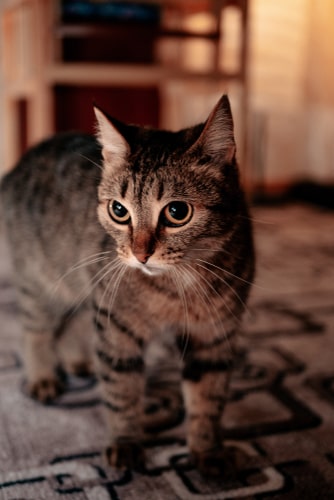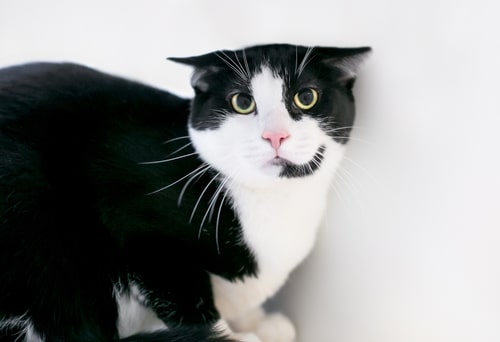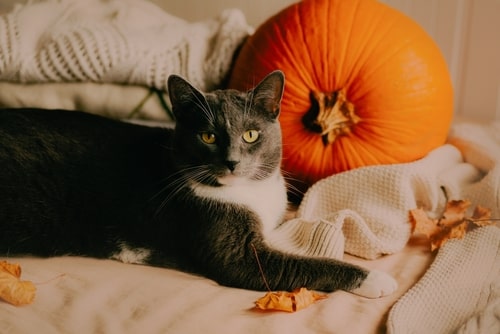
Helping Cats Stay Calm During Fireworks and Halloween | Joii Vet
Spotting the Scares: Recognising Stress in Cats
Tried-and-Tested Calming Strategies
Preparation is Key
Managing Trick-or-Treaters
Staying Calm Together on the Night
When to Call the Vet
Your Scary Season Toolkit

Helping Cats Stay Calm During Fireworks and Halloween | Joii Vet
With preparation, you can make the season of boos and bangs much calmer for your feline friend. This guide helps you:
Recognise when your cat is stressed
Understand the severity of their fear
Take practical steps to help them feel secure
Spotting the Scares: Recognising Stress in Cats
All cats respond differently to stress. Vets typically classify stress as mild, moderate or severe.
Mild stress
Hiding briefly during the stressful period
Dilated pupils
Twitching tail or flicking ears
-
Slightly reduced appetite or play

Moderate stress
Hiding away for hours
Ears flattened and crouched posture
Overgrooming
Trembling or shaking
Drooling
Rapid breathing
Vocalising (meowing)
-
House soiling (peeing in places they shouldn’t)

Severe stress
Intense panic and frantic escape attempts
Fast or open-mouth breathing (seek immediate vet advice)
Aggressive reactions in extreme circumstances
Hiding persistently, refusing food or interaction
Stress-related illness: vomiting, diarrhoea, cat flu symptoms, urinary problems
If your cat’s stress lasts beyond fireworks or affects their health, contact your vet promptly.
Tried-and-Tested Calming Strategies
The best approach will depend on how severe your cat’s stress is.
Mild cases
Create a safe space: a quiet room with bedding, blankets, and hiding spots
Block out scary sights and sounds: close curtains, play TV or calming music
Use pheromone support: Feliway diffusers mimic a mother cat’s calming scent
Provide distraction: puzzle toys, lick mats or gentle play
-
Maintain routines: keep feeding, play and cuddles consistent

Moderate cases
Secure the safe space: make it darker and cosier
Keep cats indoors: provide a litter tray and ensure escape routes are blocked
Consider vet-approved calming supplements or chews, such as Feliway Happy Snacks
Limit exposure: move cats to a quieter area during fireworks
Severe cases
Contact your vet early: prescription medication may be necessary
Monitor health: stress can trigger urinary and digestive issues
Plan long-term: vet or behaviourist support for ongoing anxiety
Preparation is Key
Start early: introduce pheromone diffusers weeks before fireworks
Safe-space familiarity: let your cat get used to their ‘den’
Keep to routine: as much as possible
Check microchips: ensure details are current in case of escape
Managing Trick-or-Treaters
Bring cats indoors well before dusk
Locate safe spaces well away from doors and noise
Reduce disturbances: answer the door quickly or leave treats outside!
Avoid dressing your cat up: most cats find this stressful
Staying Calm Together on the Night
Let your cat choose: don’t drag your cat out of hiding if they retreat
Offer soothing aids such as the Feliway spray
Mirror calm: cats pick up on your mood
Monitor carefully for signs of escalating stress
Never punish fear-based behaviours like scratching or spraying. It only makes things worse.
When to Call the Vet
The following symptoms are vet emergencies:
Persistent open mouth-breathing
Straining to urinate or signs of urinary obstruction
Seek prompt veterinary support if you notice:
Aggression, persistent hiding, refusal to eat or toileting problems
Vomiting, diarrhoea or other stress-related illnesses
Your vet may recommend prescription medication or refer you to a behavioural specialist for an individualised support plan.
Your Scary Season Toolkit
Feliway Classic Diffuser: Offer continuous calming support at home
Feliway Spray: For quick-acting reassurance for bedding, carriers, or safe spaces
Calming supplements: Treats provide a boost for stressful situations
Puzzle feeders and toys: Provide mental stimulation and distraction during fireworks
Final Thoughts
Fireworks and Halloween can be traumatic for cats, but with preparation, safe spaces and appropriate calming aids, most can cope much better. Severe cases do require veterinary help, but acting early makes a significant difference.
Remember – your cat’s fear may change over time. Be ready with preventative strategies and reactive tools. With your calm presence and the right support, the season of “boos and bangs” doesn’t have to be so frightening for your feline friend.













